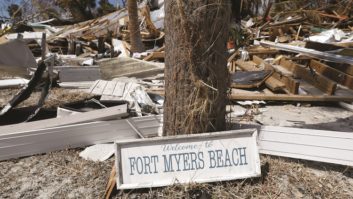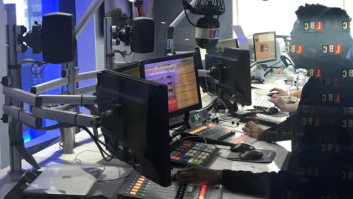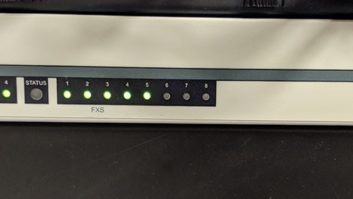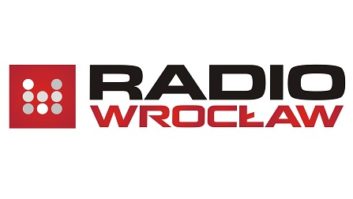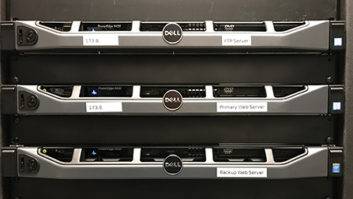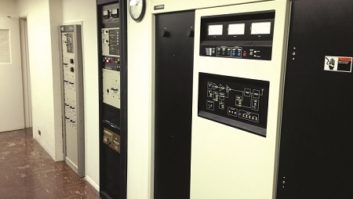Build Better Backups
Nov 1, 2013 7:00 PM, By Doug Irwin, CPBE DRB AMD
In 1986 I started at my first major-market radio job, and on my first day, while sitting in the engineering office with the chief, the GM came through (mainly because the shortest route from the sales department to the men’s room was through engineering). “We spend a million dollars a year on promotion, and we don’t want to be off the air,” is all I remember him saying in that brief introduction. He was serious, obviously, but he hardly needed to tell me that. You learn from day one when you get in to broadcasting that the station shouldn’t be off the air at all. And if it is, the need to rectify the situation is immediate and trumps all else. The worst thing in this job (at least in my opinion) is that moment you find out the station (or one of many) is off-the-air, not knowing the cause or obvious the solution. Much of my career has been spent minimizing those instances.

Everyone, from management down, will say, “We can’t be off the air,” but in reality, this question needs to be asked: “How badly do you want to stay on the air, really?” The answer will likely be rhetorical; the truth will show through once resources — whether they are money or time — become allocated.
I know many stations have a single thread made up of a single STL (whether it is radio or wireline) followed by one transmitter followed by one antenna. Usually in this case there is a single power source as well. Those situations are, in a certain sense, far easier to deal with than systems with multiple layers of redundancy. With the single thread, everyone knows that the failure of any link takes the station out, and nothing can be done except to fix the broken part as soon as practicable. Power failures at the transmitter site (as an example) can take a station out for days on end. The station engineer can shrug his or her shoulders and say, “Oh well — if they just bought another (insert device name) then this wouldn’t be happening!”
When the station takes the notion “We can’t be off the air” more seriously, the job gets harder of course. Broadcasting isn’t the most lucrative of businesses, as we all know. Rarely are there resources necessary to make the job at hand easy; often some sort of technological strategy must be employed. Let’s look at a simple example. A station gets a new transmitter, and the decision is made to keep the old one as the backup. Very common occurrence, right? But it’s not as simple as just keeping old Betsy. To keep this old transmitter available, you’ll have to consider the following: Is there enough physical space for a second transmitter? Is there enough electricity available to run a second transmitter? How will I put the old transmitter on the air, should I need to: coaxial relay or patchbay? How will I test this transmitter? I also need a dummy load… So after considering these things, you make up a budget, and go to station management. Before you take the budget, and your plan, into management, ask yourself that question: “How badly do I want to stay on-the-air, really?” Once you deliver your plan and budget, you’ll get a good idea of how your management answers that same question.
What’s under your control?
Now let’s jump ahead and consider a station that has multiple levels of redundancy, established over years, perhaps before you even got there. It’s nice to inherit a situation that is well considered and maintained. There are two transmitters, or perhaps more, with an easy means of testing during normal hours (i.e. a dummy load). There are two STLs, or perhaps more, and they all work and sound fine on-the-air. There are two antennas, each of which gets out so you don’t feel as though you’re handicapping the station while testing one. You have a large generator, that can run at least two transmitters at once, serviced regularly, and you have confidence in it.
What else could one want in a transmitter site? Your job is to take care of all the things under your control: You fix broken transmitters, STLs and everything else. It’s all up to you, and nothing is standing in your way.
– continued on page 2
Build Better Backups
Nov 1, 2013 7:00 PM, By Doug Irwin, CPBE DRB AMD
Well, let’s consider some other potential issues, even with the transmitter site described. Let your pessimistic imagination run wild — or let your prior (hard-fought) experience have a say.
� Are both antennas on the same tower?
This is an obvious flaw. If the tower falls over because of a weather event, you’re dead. I’ve seen it happen (in California, no less). Tower maintenance issues can also be problematic.
� How is access to the transmitter site?
Again, think about weather-related events. Can you even get to the transmitter site under all circumstances? Probably not. Is the road too snowy? Is it flooded out because of a hurricane? Have trees fallen over the road? Have the authorities closed it down for some reason, like a forest fire?
� What’s the generator status?
It’s important to have a reliable generator, clearly. How long of a power failure can be covered? Is there enough fuel to last a week? Longer? If not, can you get a delivery, or is a fuel vehicle unable to drive up the road? Is the fuel provider open for business? Can you contact the generator tech? Can he get to the site?

Having two of everything is the start of a good back-up plan, but also make a plan on how the equipment will be used when needed. Photo by Clay Freinwald.
� Vulnerable point: The three-phase main distribution panel.
If this panel encounters problems, then you’re really in trouble. You can do I.R. studies, and maintain it, but no guarantees, of course.
If your transmitter meets these basic checks, you’re have a highly reliable backup plan in place. If you want to be on 99.9 percent of the time, you’re set. But if you want to stay on the air no matter what, there’s more work ahead.
Alternate transmitter sites
No one can guarantee 100 percent on-air reliability mainly because, no matter how hard you try, there are circumstances out of your control. I would say 99.9 percent is pretty good goal, though. Having an alternate transmitter site is one way to overcome some of the obstacles in the planning I mentioned earlier. There are two alternate transmitter sites with which I am familiar that do just that.
Cougar Mountain

The combiner room at the Cougar Mountain transmitter site. Photo by Clay Freinwald.
Cougar Mountain has one of the best and most well-known alternate transmitter sites in the country, for many reasons. Most of Seattle’s FM stations broadcast from Tiger Mountain while maintaining backup sites at Cougar. My friend Clay Freinwald was a principal in the development of many of the backup transmitter facilities there and generously agreed to tell me about its history and capabilities.
– continued on page 3
Build Better Backups
Nov 1, 2013 7:00 PM, By Doug Irwin, CPBE DRB AMD
As in many other markets, while FM became more and more important, transmitter sites sprouted at various locations scattered about the metropolitan area. In 1987 Clay moved the first station (then KBSG, 97.3) to Tiger Mountain. It soon became clear that Tiger was a great site for FM. Over the next few years, 10 more stations moved there. A large combiner was installed along with a master antenna. Tiger, however, is notorious for harsh winter conditions, since it’s more than 3,000′ tall, at 47 degrees latitude. Along with all the benefits of Tiger came the liability of accessibility problems in wintertime. Entercom, who at that time owned five FMs in the market, also had a site at Cougar Mountain, which is at about 1,400′ of elevation, closer into downtown Seattle, and basically continually accessible even in the winter. The Entercom management decided to consolidate all of the auxiliary (formerly main) sites at one location — on land that they owned on Cougar. Another combiner, and master antenna, were built and installed at Cougar. Other FMs (notably KING-FM) joined in and became tenants of Entercom at both sites.
Eventually ATC built another site on Tiger, complete with a large combiner and master antenna, at a site slightly east of Entercom’s. That site’s major tenants, CBS and Sandusky (now Hubbard) also maintain complete backups at Cougar.
As expected, over the 13 years that the Cougar site has existed, its benefits came into play many times. The power feed up to the west Tiger mountain site is buried along the road; when it fails, the power company also has a hard time getting in to fix it. Extended power outages there have created situations where the diesel levels ran low, since no one could get in to make deliveries. The Cougar site, which was meticulously designed to provide coverage as close to that of Tiger as is possible — was then used. Tower and antenna maintenance and repair instances are done during normal daylight hours without drama — the stations just use their Cougar site. It’s not just during weather extremes that Cougar sees use though. Each station has AutoPilot running, and transmitter failures at Tiger prompt their complements at Cougar to come up automatically. Through some geographic good-fortune, both Cougar and Tiger are along almost the same line looking southeast from Seattle; so one RF-STL shot from a studio there illuminates both sites.
I can tell you from my own experience with backup transmitter sites that routine maintenance is also greatly simplified when you have an alternate transmitter site. The work that would normally have to be done at night (because it would take the station off-air) can be done during normal hours at the main site, while the other site is on-air.
Clay summed up the entire notion of alternate sites quite well. “Although some stations at West Tiger have auxiliary transmitters there — It would be foolish to not create 100 percent redundancy. 100 percent redundancy means not having all your eggs in one basket; that is, having a complete duplicate at another location with nothing in common with the mains.”
– continued on page 4
Build Better Backups
Nov 1, 2013 7:00 PM, By Doug Irwin, CPBE DRB AMD
Four Times Square

The combiner room at 4 Times Square as it was being installed. Photo by John M. Lyons.
Four Times Square is one of the best-known alternate transmitter sites in the United States. But why was it originally built? When the 9/11 attacks occurred, Josh Hadden (the CE of WKTU and Z100 at the time) already had a backup facility ready to go there; WKTU turned on the 4TS site shortly after the attack began. Let me give you just a small excerpt from a memo he had written, in August 1998, explaining to his then GM about why an alternate site was needed:
“What kind of problem could result in our not being able to broadcast from our primary location (then WTC)? Most dramatically, is the bombing of the World Trade Center (in 1993). This bombing resulted in WKTU (then WYNY) ceasing operations from WTC for weeks, as the FBI investigated, and structural engineers worked to reinforce the badly damaged foundations of the building. Initially, there was even some concern that the building would have to come down altogether. After a month of being closed, the World Trade Center reopened, but with significant deficiencies. For four years, WKTU dealt with unexpected power outages, a result of soot and smoke having gotten in to electrical switch gear…”

4 Times Square as the finishing touches were being put into place. Photo by John M. Lyons.
Other reasons were given, in the same memo, not the least of which was a two-week total shut down of the master antenna planned for June of 1999.
John Lyons (of WAXQ), Jim Stagnitto (of WWPR) and Nick Doshi (of WLTW) all had plans at the beginning of the last decade to build at 4TS as well, and eventually the plans were carried out. Fast forward to today: Clear Channel has backup transmitters for its five NYC FMs at 4TS. New York Public Radio (WNYC and WQXR) has its backups there, as does Spanish Broadcasting. WKCR and WNYE transmit from the site full-time. Most of the FM stations that transmit full-time from the Empire State Building have alternate transmitter sites either in Manhattan, or just across the Hudson in New Jersey.

Transmission line being hauled up to the 4 Times Square tower site. Photo by John M. Lyons.
The 4TS site is equipped with a large Shively combiner, and Shively master antenna up on the building-top tower that was enlarged after 9/11. The building supplies chilled water for air conditioning purposes, as well as backup ac power, with systems maintained by the building engineers themselves.
Clearly the WTC 1993 bombing and subsequent destruction in 2001 were extreme cases; and as you might expect, the “we don’t want to be off the air, no matter what” attitude is pervasive in New York. (Josh has worked under that guideline for a long time — and he’s been the Clear Channel NY DoE for 10-plus years now.) CC has main and backup transmitters at ESB, in addition to the single ones at 4TS — so, each station has three transmitters total. At ESB, all the master FM users have access to the main and backup antennas; at 4TS, there is also a main and backup antenna. Each of the five CC stations at 4TS had the same STL arrangement as ESB: the main STL (Worldcast Systems Oslo using AoIP over a private IP network); a 950MHz radio link; and finally, a pair of 15kHz “analog” (which are really digital) phone lines from the studio. There are two Audemat Relios on site for remote control; one manages WKTU, WHTZ and WAXQ. The second one manages WWPR and WLTW.
– continued on page 5
Build Better Backups
Nov 1, 2013 7:00 PM, By Doug Irwin, CPBE DRB AMD

The current 4 Times Square installation. Photo by John M. Lyons.
At this point you might be asking, “What’s the payoff? This all sounds impossibly expensive.” Well, there was an instance about three years ago when one of the power dividers on the master antenna flamed out, and we used 4TS for nine days straight at our full ERP while some other stations opted to use the upper bay of the ESB antenna at 1/4 of their nominal ERP. (If you look at a typical ESB license (using Z100 as an example) you’ll note that the ERP is 6kW with a height above average terrain of 415 meters. The corresponding auxiliary license for 4TS is 13kW with an HAAT of 281 meters.) Then there was the time at the end of last year when a water leak directly over the Z100 transmitter (completely out of our control) took out the main transmitter at 3 p.m. on a Friday. 4TS put itself on the air automatically, then called and e-mailed me to tell me about it. Oh yes — then there was the time, about a year ago, when we had a weather event, which is now known simply as “Sandy” that effectively took out our ESB transmitters leaving us with our 4TS site and its full capability.
Any transmitter site, even with the best redundancy, is still subject to problems that are out of your control: weather events, such as tornadoes, floods, hurricanes. Mountain top sites can be snowed in during the winter and exposed to forest fires during the summer. If the opportunity presents itself for you to develop an alternative transmitter site, I recommend taking it. The extra peace of mind one develops knowing your plans are in place is really satisfying and ultimately makes this job easier.
Irwin is RF engineer/project manager for Clear Channel Los Angeles. Contact him at [email protected].
November 2013
Build an effective back-up transmitter site, step inside WTMD, the FCC updates RF exposure rules, and Wheatstone baseband192 is explained….





